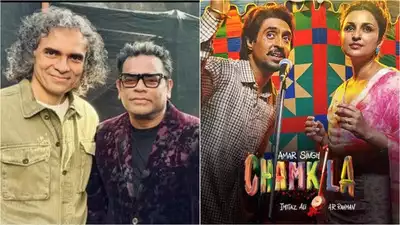‘Amar Singh Chamkila’ creative insights revealed by Imtiaz Ali: AR Rahman’s influence, fourth wall cracks, and more
In his conversation, director Imtiaz Ali explored the artistic intricacies of his most recent picture, “Amar Singh Chamkila,” illuminating avant-garde decisions including musical pieces that burst through the fourth wall, split-screen montages, and Punjabi song translations on screen.

Imtiaz said in an NDTV interview that composer AR Rahman provided inspiration for a few of these concepts.Despite Chamkila’s terrible background, Rahman argued for a joyful tone and suggested a musical theater approach to the song sequences. “There was a compulsion to break the grammar,” Imtiaz said. He went on to discuss how delicate occasions, like celebrations turning into accidents, may be portrayed using animation.
Imtiaz went into more detail about the innovative choices made along the way. The sequence when the ceiling collapses and the ladies fall, for instance, was difficult to watch. It represents the artist’s accomplishment, but it also suggests suffering for the participating ladies. They chose animation over a realistic portrayal of this. Furthermore, although though Chamkila doesn’t usually smoke in his movies, it was important to show him smoking in this one. Imtiaz addressed this by using animation once again in an effort to deter viewers from smoking.
In order to overcome the language barrier for Hindi-speaking viewers, Imtiaz Ali added text overlays to the screen to help viewers understand the original songs by Chamkila. He acknowledged that AR Rahman came up with the idea to breach the fourth wall in the musical scenes and clarified that Rahman recommended using a musical theater style to draw in viewers who were not acquainted with Chamkila. Characters in the Baaja song address the camera directly, offering varying interpretations on Chamkila’s identity
.
Imtiaz highlighted how well chosen historical images and video may envelop viewers in the veracity of Chamkila’s narrative. He spoke about how the cameraman, Diljit, Parineeti, and the rest of the actors and crew saw the events as genuine. Imtiaz wanted the audience to understand this feeling, which is why record covers and pictures would sometimes surface. These components kept the spectator rooted in the narrative by confirming Chamkila and Amarjot’s presence.
Imtiaz explained the contrast between the happy ending on film and the tragic truth of Chamkila and Amarjot’s death in response to the recurrent images of their lifeless corpses. He says that although though the movie tells the happy story of a guy meeting a girl, in actuality, both people are dead, which is why they keep cutting back to the images of the dead corpses. On April 12, “Amar Singh Chamkila” made its Netflix debut and garnered positive reviews.







